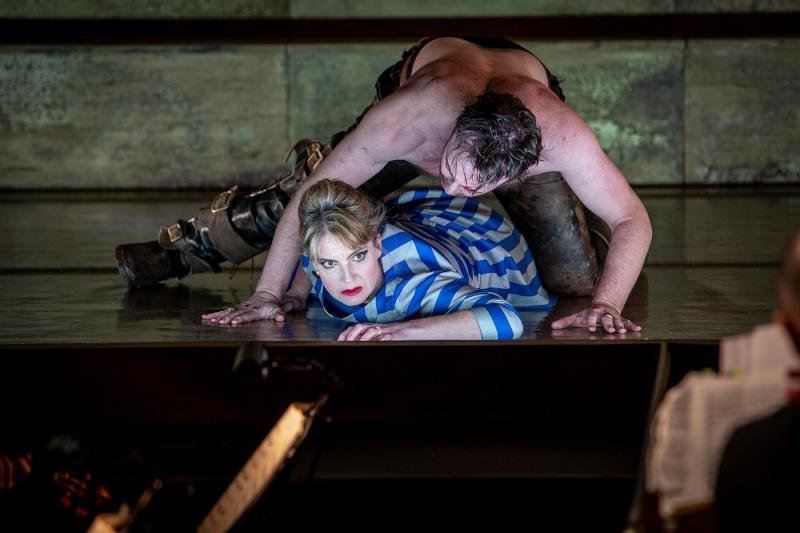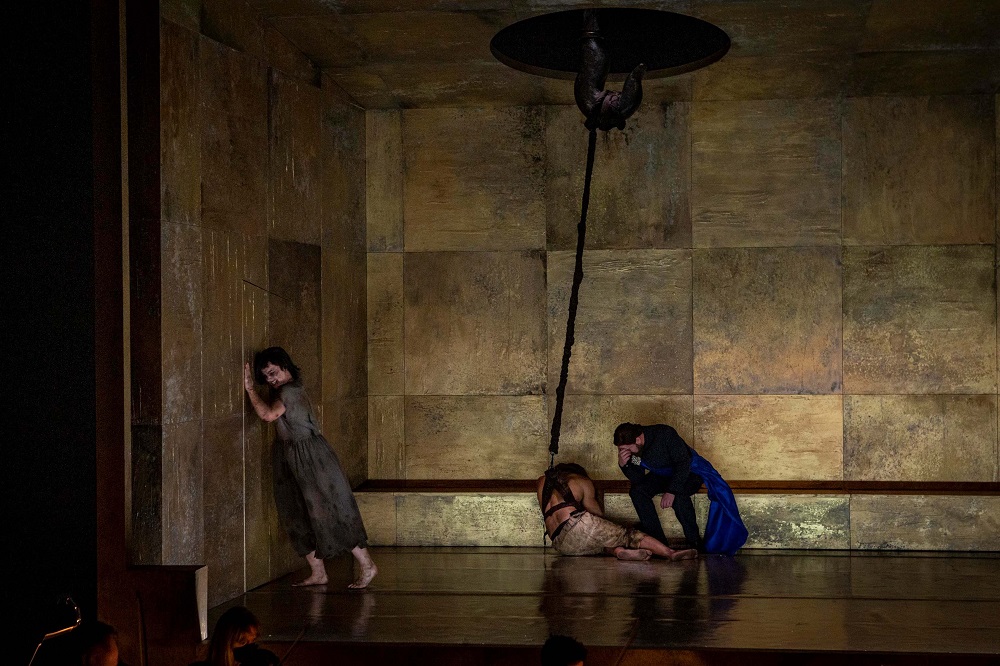Bajazet, Irish National Opera, Linbury Theatre review – robust but a bit rough | reviews, news & interviews
Bajazet, Irish National Opera, Linbury Theatre review – robust but a bit rough
Bajazet, Irish National Opera, Linbury Theatre review – robust but a bit rough
11 instrumentalists make Vivaldi rock, the shenanigans on stage not so much

One thing’s clear from Irish National Opera’s bold championship of Vivaldi: he’s his own man when it comes to the stage, not some baroque generic, even if Bajazet is a pasticcio incorporating other composers’ music.
Visually, there's much to admire. Molly O'Cathain's tarnished gold-and-wood set helps the singers to project - it's perfect for touring - and works harmoniously with a range of costume blues. The only consistent character in Adele Thomas’s production is Tamerlano, aka Timur Leng, the rapacious shepherd-conqueror who as the action starts has Ottoman Emperor Bajazet in thrall. The plot, such as it is, really revolves around which woman he will take as consort – Bajazet’s daughter Asteria, in love with Another (Greek prince Andronico) or Irene, Princess of Trebizond. But James Laing's energetic, dangerous portrayal of Tamerlano as a bare-chested, battle-scarred psychopath is compelling throughout. When he opens his mouth you think, look Tarzan, sing Jane, but the countertenor voice is about as powerful as they come, and Laing risks much in rasping it when the drama so demands.  Nobody else quite adds up, apart from baritone Gianluca Margheri’s Bajazat, an uninteresting captive invested with rough energy. Claire Booth’s Irene is caricatural as cued by her first aria, coloratura pushed to the limit as inevitable yapping, the number saved by her very definitive acting. But she remains so when you think you’re meant to sympathise. Eric Jurenas, her suitor, begins lyrically but has an unfathomably staged Act Three number, messing around with curtains to no clear ends, and forcing countertenor tone.
Nobody else quite adds up, apart from baritone Gianluca Margheri’s Bajazat, an uninteresting captive invested with rough energy. Claire Booth’s Irene is caricatural as cued by her first aria, coloratura pushed to the limit as inevitable yapping, the number saved by her very definitive acting. But she remains so when you think you’re meant to sympathise. Eric Jurenas, her suitor, begins lyrically but has an unfathomably staged Act Three number, messing around with curtains to no clear ends, and forcing countertenor tone.
Mezzo Niamh O’Sullivan (pictured above on the left with Margheri and Jurenas) has the most beautiful instrument among the voices, full of promise which needs finishing (like that of Aoife Miskelly, the cipher-helper). Yet despite slapping and beating the walls all the time in her imprisoned anguish, she doesn’t often pull focus when the instrumental playing is so wonderful (especially first violinist Julia Kuhn and lutenist – theorbist? – Sergio Bucheli, contributing surprise thunder when not offering limpid beauty).
In Act One, Vivaldi’s numbers (or whoever’s he happens to be borrowing - the other composers are Giacomelli, Hasse and Broschi) could be applied to any of the participants. Yet there’s an impressive turning of the dramatic screw at the core of Act Two, with four big scenes, Tamerlano’s especially impressive with severe unison horns. It all goes a bit slack after that, and you’re relieved when the denouement arrives. But there’s always Whelan’s phenomenally energetic direction of his players to watch – they’re the real stars of the evening.
The future of Arts Journalism
You can stop theartsdesk.com closing!
We urgently need financing to survive. Our fundraising drive has thus far raised £49,000 but we need to reach £100,000 or we will be forced to close. Please contribute here: https://gofund.me/c3f6033d
And if you can forward this information to anyone who might assist, we’d be grateful.

Subscribe to theartsdesk.com
Thank you for continuing to read our work on theartsdesk.com. For unlimited access to every article in its entirety, including our archive of more than 15,000 pieces, we're asking for £5 per month or £40 per year. We feel it's a very good deal, and hope you do too.
To take a subscription now simply click here.
And if you're looking for that extra gift for a friend or family member, why not treat them to a theartsdesk.com gift subscription?
more Opera
 La bohème, Opera North review - still young at 32
Love and separation, ecstasy and heartbreak, in masterfully updated Puccini
La bohème, Opera North review - still young at 32
Love and separation, ecstasy and heartbreak, in masterfully updated Puccini
 Albert Herring, English National Opera review - a great comedy with depths fully realised
Britten’s delight was never made for the Coliseum, but it works on its first outing there
Albert Herring, English National Opera review - a great comedy with depths fully realised
Britten’s delight was never made for the Coliseum, but it works on its first outing there
 Carmen, English National Opera review - not quite dangerous
Hopes for Niamh O’Sullivan only partly fulfilled, though much good singing throughout
Carmen, English National Opera review - not quite dangerous
Hopes for Niamh O’Sullivan only partly fulfilled, though much good singing throughout
 Giustino, Linbury Theatre review - a stylish account of a slight opera
Gods, mortals and monsters do battle in Handel's charming drama
Giustino, Linbury Theatre review - a stylish account of a slight opera
Gods, mortals and monsters do battle in Handel's charming drama
 Susanna, Opera North review - hybrid staging of a Handel oratorio
Dance and signing complement outstanding singing in a story of virtue rewarded
Susanna, Opera North review - hybrid staging of a Handel oratorio
Dance and signing complement outstanding singing in a story of virtue rewarded
 Ariodante, Opéra Garnier, Paris review - a blast of Baroque beauty
A near-perfect night at the opera
Ariodante, Opéra Garnier, Paris review - a blast of Baroque beauty
A near-perfect night at the opera
 Cinderella/La Cenerentola, English National Opera review - the truth behind the tinsel
Appealing performances cut through hyperactive stagecraft
Cinderella/La Cenerentola, English National Opera review - the truth behind the tinsel
Appealing performances cut through hyperactive stagecraft
 Tosca, Royal Opera review - Ailyn Pérez steps in as the most vivid of divas
Jakub Hrůša’s multicoloured Puccini last night found a soprano to match
Tosca, Royal Opera review - Ailyn Pérez steps in as the most vivid of divas
Jakub Hrůša’s multicoloured Puccini last night found a soprano to match
 Tosca, Welsh National Opera review - a great company reduced to brilliance
The old warhorse made special by the basics
Tosca, Welsh National Opera review - a great company reduced to brilliance
The old warhorse made special by the basics
 BBC Proms: The Marriage of Figaro, Glyndebourne Festival review - merriment and menace
Strong Proms transfer for a robust and affecting show
BBC Proms: The Marriage of Figaro, Glyndebourne Festival review - merriment and menace
Strong Proms transfer for a robust and affecting show
 BBC Proms: Suor Angelica, LSO, Pappano review - earthly passion, heavenly grief
A Sister to remember blesses Puccini's convent tragedy
BBC Proms: Suor Angelica, LSO, Pappano review - earthly passion, heavenly grief
A Sister to remember blesses Puccini's convent tragedy
 Orpheus and Eurydice, Opera Queensland/SCO, Edinburgh International Festival 2025 review - dazzling, but distracting
Eye-popping acrobatics don’t always assist in Gluck’s quest for operatic truth
Orpheus and Eurydice, Opera Queensland/SCO, Edinburgh International Festival 2025 review - dazzling, but distracting
Eye-popping acrobatics don’t always assist in Gluck’s quest for operatic truth

Add comment